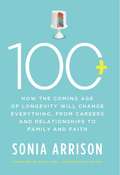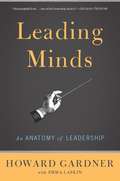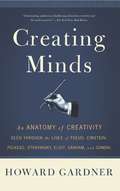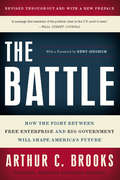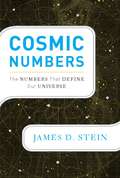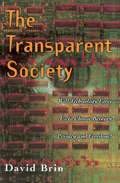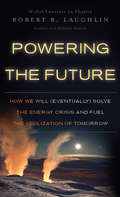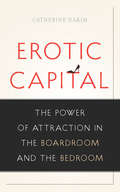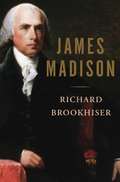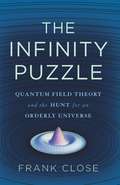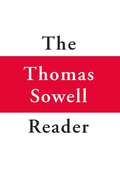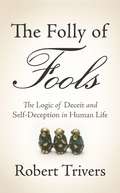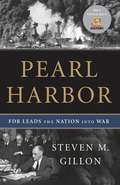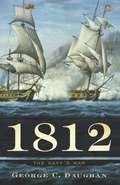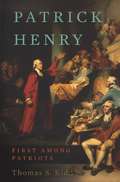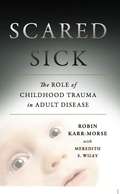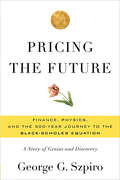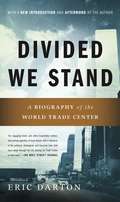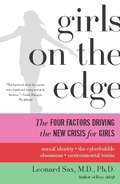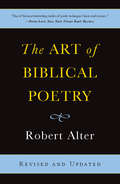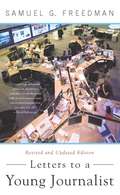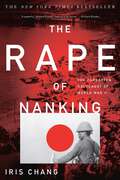- Table View
- List View
100 Plus: How the Coming Age of Longevity Will Change Everything, From Careers and Relationships to Family and
by Sonia ArrisonHumanity is on the cusp of an exciting longevity revolution. The first person to live to 150 years has probably already been born. What will your life look like when you live to be over 100? Will you be healthy? Will your marriage need a sunset clause? How long will you have to work? Will you finish one career at sixty-five only to go back to school to learn a new one? And then, will you be happily working for another sixty years? Maybe you&’ll be a parent to a newborn and a grandparent at the same time. Will the world become overpopulated? And how will living longer affect your finances, your family life, and your views on religion and the afterlife? In 100 Plus, futurist Sonia Arrison takes us on an eye-opening journey to the future at our doorsteps, where science and technology are beginning to radically change life as we know it. She introduces us to the people transforming our lives: the brilliant scientists and genius inventors and the billionaires who fund their work. The astonishing advances to extend our lives—and good health—are almost here. In the very near future fresh organs for transplants will be grown in laboratories, cloned stem cells will bring previously unstoppable diseases to their knees, and living past 100 will be the rule, not the exception. Sonia Arrison brings over a decade of experience researching and writing about cutting-edge advances in science and technology to 100 Plus, painting a vivid picture of a future that only recently seemed like science fiction, but now is very real. 100 Plus is the first book to give readers a comprehensive understanding of how life-extending discoveries will change our social and economic worlds. This illuminating and indispensable text will help us navigate the thrilling journey of life beyond 100 years.
Leading Minds: An Anatomy Of Leadership
by Howard E. GardnerFrom a pioneering psychologist and education expert, a sweeping examination of how great leaders harness the power of storiesIn Leading Minds, Howard E. Gardner and his research associate, Emma Laskin, take a novel approach to the study of leadership, exploring it from a cognitive perspective to glean powerful lessons for decision makers of all sorts. Drawing on Gardner's groundbreaking work on intelligence and creativity, they show how effective leaders both create new stories and tap into the power of existing narratives. With deep understanding, Gardner and Laskin consider a wide spectrum of leaders-including Manhattan Project director J. Robert Oppenheimer, Pope John XXIII, Eleanor Roosevelt, Margaret Thatcher, and more-to offer fascinating insights about the messages and the methods of influential people.Updated and expanded by the author, Leading Minds stands as the definitive psychological study of leadership.
Creating Minds: An Anatomy of Creativity as Seen Through the Lives of Freud, Einstein, Picasso, Stravinsky, Eliot, G
by Howard E. GardnerThis peerless classic guide to the creative self uses portraits of seven extraordinary individuals to reveal the patterns that drive the creative process -- to demonstrate how circumstance also plays an indispensable role in creative success.Howard Gardner changed the way the world thinks about intelligence. In his classic work Frames of Mind, he undermined the common notion that intelligence is a single capacity that every human being possesses to a greater or lesser extent. With Creating Minds, Gardner gives us a path breaking view of creativity, along with riveting portraits of seven figures who each reinvented an area of human endeavor. Using as a point of departure his concept of seven "intelligences," ranging from musical intelligence to the intelligence involved in understanding oneself, Gardner examines seven extraordinary individuals -- Sigmund Freud, Albert Einstein, Pablo Picasso, Igor Stravinsky, T.S. Eliot, Martha Graham, and Mahatma Gandhi -- each an outstanding exemplar of one kind of intelligence. Understanding the nature of their disparate creative breakthroughs not only sheds light on their achievements but also helps to elucidate the "modern era" -- the times that formed these creators and which they in turn helped to define. While focusing on the moment of each creator's most significant breakthrough, Gardner discovers patterns crucial to our understanding of the creative process. Creative people feature unusual combinations of intelligence and personality, and Gardner delineates the indispensable role of the circumstances in which an individual's creativity can thrive -- and how extraordinary creativity almost always carries with it extraordinary human costs.
The Battle: How the Fight between Free Enterprise and Big Government Will Shape America's Future
by Arthur C. BrooksAmerica faces a new culture war. It is not a war about guns, abortions, or gays-rather it is a war against the creeping changes to our entrepreneurial culture, the true bedrock of who we are as a people. The new culture war is a battle between free enterprise and social democracy.Many Americans have forgotten the evils of socialism and the predations of the American Great Society's welfare state programs. But, as American Enterprise Institute's president Arthur C. Brooks reveals in The Battle, the forces for social democracy have returned with a vengeance, expanding the power of the state to a breathtaking degree.The Battle offers a plan of action for the defense of free enterprise; it is at once a call to arms and a crucial redefinition of the political and moral gulf that divides Right and Left in America today. The battle is on, and nothing less than the soul of America is at stake.
Cosmic Numbers: The Numbers That Define Our Universe
by James D. SteinOur fascination with numbers begins when we are children and continues throughout our lives. We start counting our fingers and toes and end up balancing checkbooks and calculating risk. So powerful is the appeal of numbers that many people ascribe to them a mystical significance. Other numbers go beyond the supernatural, working to explain our universe and how it behaves. In Cosmic Numbers, mathematics professor James D. Stein traces the discovery, evolution, and interrelationships of the numbers that define our world. Everyone knows about the speed of light and absolute zero, but numbers like Boltzmann's constant and the Chandrasekhar limit are not as well known, and they do far more than one might imagine: They tell us how this world began and what the future holds. Much more than a gee-whiz collection of facts and figures, Cosmic Numbers illuminates why particular numbers are so important-both to the scientist and to the rest of us.
The Transparent Society: Will Technology Force Us To Choose Between Privacy And Freedom?
by David BrinIn New York and Baltimore, police cameras scan public areas twenty-four hours a day. Huge commercial databases track you finances and sell that information to anyone willing to pay. Host sites on the World Wide Web record every page you view, and "smart” toll roads know where you drive. Every day, new technology nibbles at our privacy.Does that make you nervous? David Brin is worried, but not just about privacy. He fears that society will overreact to these technologies by restricting the flow of information, frantically enforcing a reign of secrecy. Such measures, he warns, won't really preserve our privacy. Governments, the wealthy, criminals, and the techno-elite will still find ways to watch us. But we'll have fewer ways to watch them. We'll lose the key to a free society: accountability.The Transparent Society is a call for "reciprocal transparency.” If police cameras watch us, shouldn't we be able to watch police stations? If credit bureaus sell our data, shouldn't we know who buys it? Rather than cling to an illusion of anonymity-a historical anomaly, given our origins in close-knit villages-we should focus on guarding the most important forms of privacy and preserving mutual accountability. The biggest threat to our freedom, Brin warns, is that surveillance technology will be used by too few people, now by too many.A society of glass houses may seem too fragile. Fearing technology-aided crime, governments seek to restrict online anonymity; fearing technology-aided tyranny, citizens call for encrypting all data. Brins shows how, contrary to both approaches, windows offer us much better protection than walls; after all, the strongest deterrent against snooping has always been the fear of being spotted. Furthermore, Brin argues, Western culture now encourages eccentricity-we're programmed to rebel! That gives our society a natural protection against error and wrong-doing, like a body's immune system. But "social T-cells” need openness to spot trouble and get the word out. The Transparent Society is full of such provocative and far-reaching analysis.The inescapable rush of technology is forcing us to make new choices about how we want to live. This daring book reminds us that an open society is more robust and flexible than one where secrecy reigns. In an era of gnat-sized cameras, universal databases, and clothes-penetrating radar, it will be more vital than ever for us to be able to watch the watchers. With reciprocal transparency we can detect dangers early and expose wrong-doers. We can gauge the credibility of pundits and politicians. We can share technological advances and news. But all of these benefits depend on the free, two-way flow of information.
Powering the Future: How We Will (Eventually) Solve the Energy Crisis and Fuel the Civilization of Tomorrow (Playaway Adult Nonfiction Ser.)
by Robert B. LaughlinIn Powering the Future, Nobel laureate Robert B. Laughlin transports us two centuries into the future, when we&’ve ceased to use carbon from the ground—either because humans have banned carbon burning or because fuel has simply run out. Boldly, Laughlin predicts no earth-shattering transformations will have taken place. Six generations from now, there will still be soccer moms, shopping malls, and business trips. Firesides will still be snug and warm.How will we do it? Not by discovering a magic bullet to slay our energy problems, but through a slew of fascinating technologies, drawing on wind, water, and fire. Powering the Future is an objective yet optimistic tour through alternative fuel sources, set in a world where we&’ve burned every last drop of petroleum and every last shovelful of coal. The Predictable: Fossil fuels will run out. The present flow of crude oil out of the ground equals in one day the average flow of the Mississippi River past New Orleans in thirteen minutes. If you add the energy equivalents of gas and coal, it&’s thirty-six minutes. At the present rate of consumption, we&’ll be out of fossil fuels in two centuries&’ time. We always choose the cheapest gas. From the nineteenth-century consolidation of the oil business to the California energy crisis of 2000-2001, the energy business has shown, time and again, how low prices dominate market share. Market forces—not green technology—will be the driver of energy innovation in the next 200 years. The laws of physics remain fixed. Energy will still be conserved, degrade entropically with use, and have to be disposed of as waste heat into outer space. How much energy a fuel can pack away in a given space is fixed by quantum mechanics—and if we want to keep flying jet planes, we will need carbon-based fuels. The Potential: Animal waste.If dried and burned, the world&’s agricultural manure would supply about one-third as much energy as all the coal we presently consume. Trash. The United States disposes of 88 million tons of carbon in its trash per year. While the incineration of waste trash is not enough to contribute meaningfully to the global demand for energy, it will constrain fuel prices by providing a cheap supply of carbon. Solar energy.The power used to light all the cities around the world is only one-millionth of the total power of sunlight pouring down on earth&’s daytime side. And the amount of hydropump storage required to store the world&’s daily electrical surge is equal to only eight times the volume of Lake Mead. PRAISE FOR ROBERT B. LAUGHLIN &“Perhaps the most brilliant theoretical physicist since Richard Feynman&”—George Chapline, Lawrence Livermore National Laboratory &“Powerful but controversial.&”— Financial Times &“[Laughlin&’s] company … is inspirational.&” —New Scientist
Erotic Capital: The Power of Attraction in the Boardroom and the Bedroom
by Catherine HakimIn 2010, pioneering sociologist Catherine Hakim shocked the world with a provocative new theory: In addition to the three recognized personal assets (economic, cultural, and social capital), each individual has a fourth asset-erotic capital-that he or she can, and should, use to advance within society. In this bold and controversial book, Hakim explores the applications and significance of erotic capital, challenging the disapproval meted out to women and men who use sex appeal to get ahead in life. Social scientists have paid little serious attention to these modes of personal empowerment, despite overwhelming evidence of their importance. In Erotic Capital, Hakim marshals a trove of research to show that rather than degrading those who employ it, erotic capital represents a powerful and potentially equalizing tool-one that we scorn only to our own detriment.
James Madison
by Richard BrookhiserA vivid portrait of the "Father of the Constitution"James Madison led one of the most influential and prolific lives in American history, and his story--although all too often overshadowed by his more celebrated contemporaries--is integral to that of the nation. Madison helped to shape our country as perhaps no other Founder: collaborating on the Federalist Papers and the Bill of Rights, resisting government overreach by assembling one of the nation's first political parties (the Republicans, who became today's Democrats), and taking to the battlefield during the War of 1812, becoming the last president to lead troops in combat. In this penetrating biography, eminent historian Richard Brookhiser presents a vivid portrait of the "Father of the Constitution," an accomplished yet humble statesman who nourished Americans' fledgling liberty and vigorously defended the laws that have preserved it to this day.
James Madison
by Richard BrookhiserJames Madison led one of the most influential and prolific lives in American history, and his story -- although all too often overshadowed by his more celebrated contemporaries -- is integral to that of the nation. Madison helped to shape our country as perhaps no other Founder: collaborating on the Federalist Papers and the Bill of Rights, resisting government overreach by assembling one of the nation's first political parties (the Republicans, who became today's Democrats), and taking to the battlefield during the War of 1812, becoming the last president to lead troops in combat. In this penetrating biography, eminent historian Richard Brookhiser presents a vivid portrait of the "Father of the Constitution," an accomplished yet humble statesman who nourished Americans' fledgling liberty and vigorously defended the laws that have preserved it to this day.
The Infinity Puzzle: Quantum Field Theory and the Hunt for an Orderly Universe
by Frank CloseSpeculation is rife that by 2012 the elusive Higgs boson will be found at the Large Hadron Collider. If found, the Higgs boson would help explain why everything has mass. But there's more at stake-what we're really testing is our capacity to make the universe reasonable. Our best understanding of physics is predicated on something known as quantum field theory. Unfortunately, in its raw form, it doesn't make sense-its outputs are physically impossible infinite percentages when they should be something simpler, like the number 1. The kind of physics that the Higgs boson represents seeks to "renormalize" field theory, forcing equations to provide answers that match what we see in the real world.The Infinity Puzzle is the story of a wild idea on the road to acceptance. Only Close can tell it.
The Thomas Sowell Reader (Playaway Adult Nonfiction Ser.)
by Thomas SowellA one-volume introduction to over three decades of the wide-ranging writings of one of America's most respected and cited authorsThese selections from the many writings of Thomas Sowell over a period of a half century cover social, economic, cultural, legal, educational, and political issues. The sources range from Dr. Sowell's letters, books, newspaper columns, and articles in both scholarly journals and popular magazines. The topics range from late-talking children to "tax cuts for the rich," baseball, race, war, the role of judges, medical care, and the rhetoric of politicians. These topics are dealt with by sometimes drawing on history, sometimes drawing on economics, and sometimes drawing on a sense of humor.The Thomas Sowell Reader includes essays on:* Social Issues* Economics* Political Issues* Legal Issues* Race and Ethnicity* Educational Issues* Biographical Sketches* Random Thoughts "My hope is that this large selection of my writings will reduce the likelihood that readers will misunderstand what I have said on many controversial issues over the years. Whether the reader will agree with all my conclusions is another question entirely. But disagreements can be productive, while misunderstandings seldom are."--Thomas Sowell
The Folly of Fools: The Logic of Deceit and Self-Deception in Human Life
by Robert TriversA New York Times Notable Book of 2012Whether it&’s in a cockpit at takeoff or the planning of an offensive war, a romantic relationship or a dispute at the office, there are many opportunities to lie and self-deceive—but deceit and self-deception carry the costs of being alienated from reality and can lead to disaster. So why does deception play such a prominent role in our everyday lives? In short, why do we deceive?In his bold new work, prominent biological theorist Robert Trivers unflinchingly argues that self-deception evolved in the service of deceit—the better to fool others. We do it for biological reasons—in order to help us survive and procreate. From viruses mimicking host behavior to humans misremembering (sometimes intentionally) the details of a quarrel, science has proven that the deceptive one can always outwit the masses. But we undertake this deception at our own peril.Trivers has written an ambitious investigation into the evolutionary logic of lying and the costs of leaving it unchecked.
Pearl Harbor: FDR Leads the Nation Into War (Playaway Adult Nonfiction Ser.)
by Steven M. GillonFranklin D. Roosevelt famously called December 7, 1941, "a date which will live in infamy.” History would prove him correct; the events of that day-when the Japanese bombed Pearl Harbor-ended the Great Depression, changed the course of FDR's presidency, and swept America into World War II. In Pearl Harbor, acclaimed historian Steven M. Gillon provides a vivid, minute-by-minute account of Roosevelt's skillful leadership in the wake of the most devastating military assault in American history. FDR proved both decisive and deceptive, inspiring the nation while keeping the real facts of the attack a secret from congressional leaders and the public.Pearl Harbor explores the anxious and emotional events surrounding the attack on Pearl Harbor, showing how the president and the American public responded in the pivotal twenty-four hours that followed, a period in which America burst from precarious peace into total war.
1812: The Navy's War
by George C. DaughanAt the outbreak of the War of 1812, America's prospects looked dismal. It was clear that the primary battlefield would be the open ocean-but America's war fleet, only twenty ships strong, faced a practiced British navy of more than a thousand men-of-war. Still, through a combination of nautical deftness and sheer bravado, the American navy managed to take the fight to the British and turn the tide of the war: on the Great Lakes, in the Atlantic, and even in the eastern Pacific. In 1812: The Navy's War, prizewinning historian George C. Daughan tells the thrilling story of how a handful of heroic captains and their stalwart crews overcame spectacular odds to lead the country to victory against the world's greatest imperial power. A stunning contribution to military and national history, 1812: The Navy's War is the first complete account in more than a century of how the U.S. Navy rescued the fledgling nation and secured America's future.
1812: The Navy's War
by George C DaughanAt the outbreak of the War of 1812, America's prospects looked dismal. It was clear that the primary battlefield would be the open ocean -- but America's war fleet, only twenty ships strong, faced a practiced British navy of more than a thousand men-of-war. Still, through a combination of nautical deftness and sheer bravado, the American navy managed to take the fight to the British and turn the tide of the war: on the Great Lakes, in the Atlantic, and even in the eastern Pacific. In 1812: The Navy's War, prizewinning historian George C. Daughan tells the thrilling story of how a handful of heroic captains and their stalwart crews overcame spectacular odds to lead the country to victory against the world's greatest imperial power. A stunning contribution to military and national history, 1812: The Navy's War is the first complete account in more than a century of how the U.S. Navy rescued the fledgling nation and secured America's future.
Patrick Henry: First Among Patriots
by Thomas S. KiddMost Americans know Patrick Henry as a fiery speaker whose pronouncement "Give me liberty or give me death!” rallied American defiance to the British Crown. But Henry's skills as an orator-sharpened in the small towns and courtrooms of colonial Virginia-are only one part of his vast, but largely forgotten, legacy. As historian Thomas S. Kidd shows, Henry cherished a vision of America as a virtuous republic with a clearly circumscribed central government. These ideals brought him into bitter conflict with other Founders and were crystallized in his vociferous opposition to the U.S. Constitution. In Patrick Henry, Kidd pulls back the curtain on one of our most radical, passionate Founders, showing that until we understand Henry himself, we will neglect many of the Revolution's animating values.
Patrick Henry: First Among Patriots
by Thomas S KiddMost Americans know Patrick Henry as a fiery speaker whose pronouncement "Give me liberty or give me death!" rallied American defiance to the British Crown. But Henry's skills as an orator -- sharpened in the small towns and courtrooms of colonial Virginia -- are only one part of his vast, but largely forgotten, legacy. As historian Thomas S. Kidd shows, Henry cherished a vision of America as a virtuous republic with a clearly circumscribed central government. These ideals brought him into bitter conflict with other Founders and were crystallized in his vociferous opposition to the U.S. Constitution. In Patrick Henry, Kidd pulls back the curtain on one of our most radical, passionate Founders, showing that until we understand Henry himself, we will neglect many of the Revolution's animating values.
Scared Sick: The Role of Childhood Trauma in Adult Disease
by Robin Karr-MorseThe first years of human life are more important than we ever realized. In Scared Sick, Robin Karr-Morse connects psychology, neurobiology, endocrinology, immunology, and genetics to demonstrate how chronic fear in infancy and early childhood- when we are most helpless-lies at the root of common diseases in adulthood. Compassionate and based on the latest research, Scared Sick will unveil a major public health crisis. Highlighting case studies and cutting-edge scientific findings, Karr- Morse shows how our innate fight-or-flight system can injure us if overworked in the early stages of life. Persistent stress can trigger diabetes, heart disease, obesity, depression, and addiction later on.
Pricing the Future: Finance, Physics, and the 300-year Journey to the Black-Scholes Equation
by George G. SzpiroOptions have been traded for hundreds of years, but investment decisions were based on gut feelings until the Nobel Prize-winning discovery of the Black-Scholes options pricing model in 1973 ushered in the era of the "quants.” Wall Street would never be the same. In Pricing the Future, financial economist George G. Szpiro tells the fascinating stories of the pioneers of mathematical finance who conducted the search for the elusive options pricing formula. From the broker's assistant who published the first mathematical explanation of financial markets to Albert Einstein and other scientists who looked for a way to explain the movement of atoms and molecules, Pricing the Future retraces the historical and intellectual developments that ultimately led to the widespread use of mathematical models to drive investment strategies on Wall Street.
Divided We Stand: A Biography Of New York's World Trade Center
by Eric DartonWhen the World Trade Towers in New York City were erected at the Hudson's edge, they led the way to a real estate boom that was truly astonishing. Divided We Stand reveals the coming together and eruption of four volatile elements: super-tall buildings, financial speculation, globalization, and terrorism. The Trade Center serves as a potent symbol of the disastrous consequences of undemocratic planning and development.This book is a history of that skyscraping ambition and the impact it had on New York and international life. It is a portrait of a building complex that lives at the convergence point of social and economic realities central not only to New York City but to all industrial cities and suburbs. A meticulously researched historical account based on primary documents, Divided We Stand is a contemporary indictment of the prevailing urban order in the spirit of Jane Jacobs's mid-century classic The Death and Life of Great American Cities.
Girls on the Edge: The Four Factors Driving the New Crisis for Girls-Sexual Identity, the Cyberbubble, Obsessions, Envi
by Leonard SaxA parenting expert reveals the four biggest threats to girls' psychological growth and explains how parents can help their daughters develop a healthy sense of self.In Girls on the Edge, psychologist and physician Leonard Sax argues that many girls today have a brittle sense of self-they may look confident and strong on the outside, but they're fragile within. Sax offers the tools we need to help them become independent and confident women, and provides parents with practical tips on everything from helping their daughter limit her time on social media, to choosing a sport, to nurturing her spirit through female-centered activities. Compelling and inspiring, Girls on the Edge points the way to a new future for today's girls and young women.
The Art of Biblical Poetry
by Robert AlterThree decades ago, renowned literary expert Robert Alter radically expanded the horizons of biblical scholarship by recasting the Bible as not only a human creation but a work of literary art deserving studied criticism. In The Art of Biblical Poetry, his companion to the seminal The Art of Biblical Narrative, Alter takes his analysis beyond narrative craft to investigate the use of Hebrew poetry in the Bible. Updated with a new preface, myriad revisions, and passages from Alter's own critically acclaimed biblical translations, The Art of Biblical Poetry is an indispensable tool for understanding the Bible and its poetry.
Letters to a Young Journalist (Art Of Mentoring Ser.)
by Samuel G. FreedmanOver the course of a thirty-year career, Samuel Freedman has excelled both at doing journalism and teaching it, and he passionately engages both of these endeavors in the pages of this book. As an author and journalist, Freedman has produced award-winning books, investigative series, opinion columns, and feature stories and has become a specialist in a wide variety of fields. As a teacher, he has shared his expertise and experience with hundreds of students, who have gone on to succeed in both print and broadcast media. In Letters to a Young Journalist, Freedman conducts an extended conversation with young journalists-from kids on the high school paper to graduates starting their first jobs. Whether he's talking about radio documentaries or TV news shows, Internet blogs, or backwater beats, shoeleather research or elegant prose, his goal is to explore the habits of mind that make an excellent journalist. It is no secret that journalism's mission is seriously imperiled these days, and Freedman's provocative ideas and fascinating stories offer students and journalists at all levels of experience wise guidance and professional inspiration.
The Rape Of Nanking: The Forgotten Holocaust Of World War II
by Iris ChangThe New York Times bestselling account of one of history's most brutal -- and forgotten -- massacres, when the Japanese army destroyed China's capital city on the eve of World War II In December 1937, one of the most horrific atrocities in the long annals of wartime barbarity occurred. The Japanese army swept into the ancient city of Nanking (what was then the capital of China), and within weeks, more than 300,000 Chinese civilians and soldiers were systematically raped, tortured, and murdered. In this seminal work, Iris Chang, whose own grandparents barely escaped the massacre, tells this history from three perspectives: that of the Japanese soldiers, that of the Chinese, and that of a group of Westerners who refused to abandon the city and created a safety zone, which saved almost 300,000 Chinese. Drawing on extensive interviews with survivors and documents brought to light for the first time, Iris Chang's classic book is the definitive history of this horrifying episode. "Chang vividly, methodically, records what happened, piecing together the abundant eyewitness reports into an undeniable tapestry of horror." - Adam Hochschild, Salon
